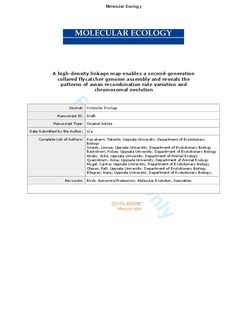| dc.contributor.author | kawakami, takeshi | |
| dc.contributor.author | smeds, Linnea | |
| dc.contributor.author | Backström, Niclas | |
| dc.contributor.author | Husby, Arild | |
| dc.contributor.author | Qvarnström, Anna | |
| dc.contributor.author | Ellegren, Hans | |
| dc.contributor.author | Olason, Pall | |
| dc.contributor.author | Mugal, Carina | |
| dc.date.accessioned | 2014-08-29T07:11:43Z | |
| dc.date.accessioned | 2016-06-02T07:36:31Z | |
| dc.date.available | 2014-08-29T07:11:43Z | |
| dc.date.available | 2016-06-02T07:36:31Z | |
| dc.date.issued | 2014-06-17 | |
| dc.identifier.citation | Molecular Ecology 2014, 23(16):4035-4058 | nb_NO |
| dc.identifier.issn | 0962-1083 | |
| dc.identifier.uri | http://hdl.handle.net/11250/2391122 | |
| dc.description.abstract | Detailed linkage and recombination rate maps are necessary to use the full potential of genome sequencing and population genomic analyses. We used a custom collared flycatcher 50 K SNP array to develop a high-density linkage map with 37 262 markers assigned to 34 linkage groups in 33 autosomes and the Z chromosome. The best-order map contained 4215 markers, with a total distance of 3132 cM and a mean genetic distance between markers of 0.12 cM. Facilitated by the array being designed to include markers from most scaffolds, we obtained a second-generation assembly of the flycatcher genome that approaches full chromosome sequences (N50 super-scaffold size 20.2 Mb and with 1.042 Gb (of 1.116 Gb) anchored to and mostly ordered and oriented along chromosomes). We found that flycatcher and zebra finch chromosomes are entirely syntenic but that inversions at mean rates of 1.5–2.0 event (6.6–7.5 Mb) per My have changed the organization within chromosomes, rates high enough for inversions to potentially have been involved with many speciation events during avian evolution. The mean recombination rate was 3.1 cM/Mb and correlated closely with chromosome size, from 2 cM/Mb for chromosomes >100 Mb to >10 cM/Mb for chromosomes <10 Mb. This size dependence seemed entirely due to an obligate recombination event per chromosome; if 50 cM was subtracted from the genetic lengths of chromosomes, the rate per physical unit DNA was constant across chromosomes. Flycatcher recombination rate showed similar variation along chromosomes as chicken but lacked the large interior recombination deserts characteristic of zebra finch chromosomes. | nb_NO |
| dc.language.iso | eng | nb_NO |
| dc.publisher | Wiley | nb_NO |
| dc.rights | Navngivelse-Ikkekommersiell-IngenBearbeidelse 3.0 Norge | * |
| dc.rights.uri | http://creativecommons.org/licenses/by-nc-nd/3.0/no/ | * |
| dc.title | A high density linkage map enables a second generation collared flycatcher genome assembly and reveals the pattern of avian recombination rate variation and chromosomal evolution. | nb_NO |
| dc.type | Journal article | nb_NO |
| dc.type | Peer reviewed | nb_NO |
| dc.date.updated | 2014-08-29T07:11:44Z | |
| dc.source.pagenumber | 4035-4058 | nb_NO |
| dc.source.volume | 23 | nb_NO |
| dc.source.journal | Molecular Ecology | nb_NO |
| dc.source.issue | 16 | nb_NO |
| dc.identifier.doi | 10.1111/mec.12810 | |
| dc.identifier.cristin | 1146126 | |
| dc.relation.project | Norges forskningsråd: 214553 | nb_NO |
| dc.description.localcode | © Wiley. This is the authors pre-refereed manuscript to the article. | nb_NO |

